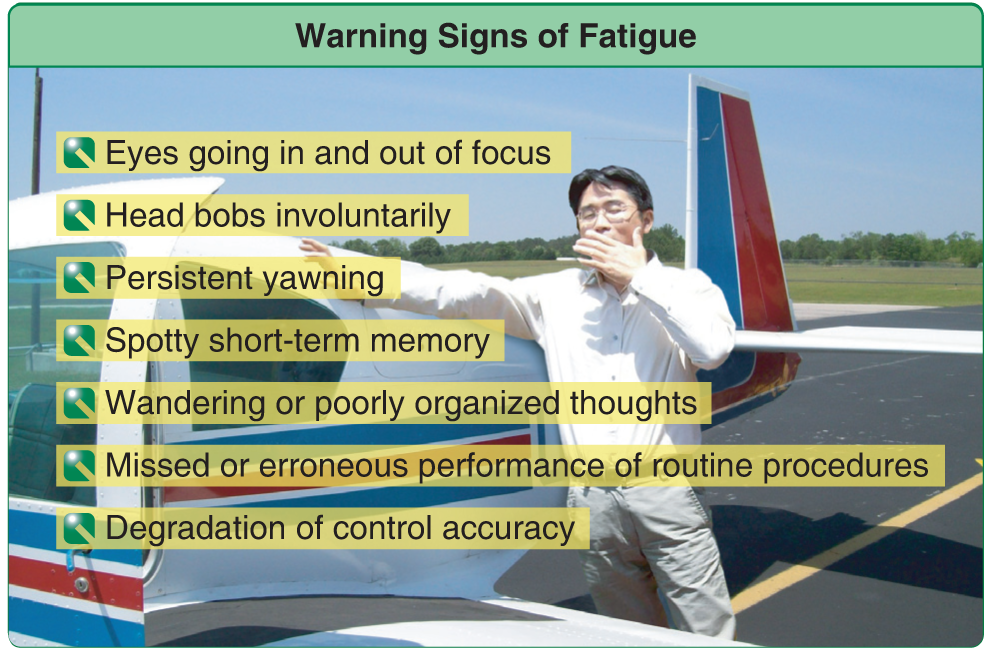IMSAFE, the not-so-subtle-phrase within the acronym. I think by this point in your training you have probably begun to realize that aviation is flooded with acronyms and abbreviations for a myriad of things. PAVE stands for Pilot, Aircraft, Environment, and External Pressure and is an essential risk management tool that assists the pilot in running a checklist of potential hazards and risks associated with a flight. The first checklist item, Pilot, is there to identify any risks associated with the pilots overall health, which is where this first acronym I mentioned comes in. IMSAFE (Illness, Medication, Stress, Alcohol, Fatigue, and Emotion) is a self-assessment checklist of you, the pilot, to determine if you are fit for duty. Honestly, we could spend all day talking about PAVE and IMSAFE but in today’s post I don’t intend to do that. I want to concentrate on one area which just happens to be one of the most “insidious hazards to flight safety,” according to the FAA.

Fatigue, the fifth item on the IMSAFE checklist, is often one of the most overlooked and undetected by a pilot. It’s extremely hard to narrow down a singular definition for fatigue because of the various causes; these can include a lack of sleep or excessive physical exertion. There are also some causes of fatigue you might not think of, for example grief, emotional stress, boredom, or even a lack of activity. The FAA best describes fatigue from an operational standpoint: “Fatigue is a condition characterized by increased discomfort with lessened capacity for work, reduced efficiency of accomplishments, loss of power or capacity to respond to stimulation, and is usually accompanied by a feeling of weariness and tiredness.”
Over recent years the FAA has expressed special emphasis on fatigue, particularly in commercial operations. We have seen numerous aviation accidents as a result of pilot error which often directly correlate to a pilot being fatigued. This was the case in the very high profile 2009 Colgan Air crash; this accident in part can be attributed to pilot fatigue.
The Pilot’s Handbook of Aeronautical Knowledge (FAA-H-8083-25) broadly classifies fatigue into two different categories: acute and chronic.
Acute fatigue is something seen in everyday life, often lasting for a short period of time. This type of fatigue results mostly from a lack of sleep or over-exertion of a physical or strenuous activity. A fluffy pillow and a good night’s rest is often the cure (8 hours of sleep is recommended).
Chronic fatigue as the name suggests is something that last over a long period of time or is constantly recurring. Continuous high stress levels or an underlying disease are often to blame. This type of fatigue leads to several other health related concerns and is not easily remedied by a good night’s rest but requires consultation with a physician. Chronic fatigue is not to be considered “normal” and you should take a hard look if this is something you are experiencing and get expert help.
No matter the classification of fatigue, it is highly advisable to stay on the ground! As the FAA says, no amount of training or experience can overcome the detrimental effects of fatigue.
The FAA provides a Fatigue Countermeasure Training Course at FAASAfety.gov , it’s about a 2.5 hour course and will provide you with Wings credit at the conclusion. Check it out!
https://www.faasafety.gov/gslac/ALC/CourseLanding.aspx?cID=174
I would also recommend you take a look through this educational brochure published by the FAA:
https://www.faa.gov/pilots/safety/pilotsafetybrochures/media/Fatigue_Aviation.pdf




